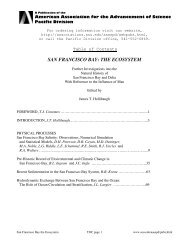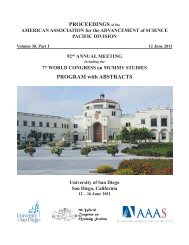Vol 31, Part I - forums.sou.edu ⢠Index page - Southern Oregon ...
Vol 31, Part I - forums.sou.edu ⢠Index page - Southern Oregon ...
Vol 31, Part I - forums.sou.edu ⢠Index page - Southern Oregon ...
Create successful ePaper yourself
Turn your PDF publications into a flip-book with our unique Google optimized e-Paper software.
ABSTRACTS – Symposia<br />
both cell lines...In SiHa cells, drug treatment induced a significant<br />
and rapid shutdown of cellular proliferation resulting<br />
from a global arrest of the cell cycle...CaSki cells also exhibited<br />
a significant decrease in cellular proliferation; however<br />
the cell population arrested at the G 1<br />
/S phase transition following<br />
treatment with AAPF CMK<br />
. In both cell lines, the HPV-<br />
16 E7 oncoprotein and the targets, pRb and E2F1, showed<br />
no significant difference after treatment...In CaSki cells, p53<br />
and p21 protein levels are significantly increased at 24 hours<br />
with a concomitant increase in p21 mRNA after AAPF CMK<br />
treatment...Although no difference in p53 and p21 protein<br />
levels was detected in SiHa cells after drug treatment, a significant<br />
increase in p21 mRNA was observed.. .Therefore,<br />
AAPF CMK<br />
treatment may potentially disrupt the ability of<br />
HPV-16 E6 to completely inhibit p53 activity...Despite the<br />
progress made by screening and vaccines, HPV infection<br />
remains a serious worldwide health problem that warrants<br />
research into additional treatment options.<br />
88 From Our Phones To Our Bones: Mechanisms of Cadmium-Induced<br />
Osteotoxicity, SARA J HEGGLAND<br />
(Department of Biology, The College of Idaho, Caldwell, ID<br />
83605; sheggland@collegeofidaho.<strong>edu</strong>).<br />
Cadmium is a toxic metal that leaches into the environment,<br />
most notably through the improper disposal of<br />
electronics. Bone is a target site for cadmium toxicity...In<br />
humans, exposure to cadmium is linked to the development<br />
of osteoporosis. Our laboratory uses an osteoblast cell line<br />
model to study the direct effects of cadmium in bone-forming<br />
osteoblasts and on the extracellular matrix (ECM) these<br />
cells produce.. . Our research demonstrates cadmium exposure<br />
activates the ERK signaling pathway leading to osteoblast<br />
apoptosis...More recently, we expanded our osteoblast<br />
studies to clarify the impact of cadmium on the ECM. Osteoblasts<br />
secrete an ECM primarily comprised of a calciumphosphate<br />
crystalline and a collagenous protein component.<br />
Our preliminary studies demonstrate that cadmium can be<br />
deposited in the ECM, which led us to hypothesize that cadmium<br />
exposure alters the nature of the ECM produced by<br />
osteoblasts. After inducing cells to mineralize, we assessed<br />
cadmium incorporation in the ECM and subsequent changes<br />
in calcium, phosphate, and collagen deposition. Using surface<br />
plasmon resonance and column chromatography we<br />
explored cadmium-collagen binding interactions. We found<br />
cadmium can bind collagen and with different affinity compared<br />
to calcium. We are currently studying whether cadmium<br />
alters collagen fibrillogenesis, which is the spontaneous<br />
formation of the fibrillar structure found in bone. Collectively,<br />
our work demonstrates that osteoblasts and the ECM<br />
they secrete are targets for cadmium toxicity, providing a<br />
mechanisms for how cadmium exposure may contribute to<br />
the pathogenesis of osteoporosis.<br />
Research funded by NIH-INBRE P20RR016454 and P20 GM103408 and<br />
NIH R15ES015866 grants.<br />
89 Mechanism of Acrylonitrile Carcinogenesis in Rat Brain:<br />
The Potential Involvement of Oxidative Stress, XINZHU<br />
PU 1 *, ZEMIN WANG 2 , SHAOYU ZHOU 2 , LISA M<br />
KAMENDULIS 2 , and JAMES E KLAUNIG 2 ( 1 Department<br />
of Biological Sciences, Boise State University, 1910<br />
University Dr., Boise, ID 83725; 2 Department of Environmental<br />
Health, Indiana University, 1025 E. Seventh Street,<br />
Bloomington, IN 4740; shinpu@boisestate.<strong>edu</strong>).<br />
Acrylonitrile is a heavily used chemical in the manufacturing<br />
of plastics, acrylic fibers, and synthetic rubber.<br />
Chronic exposure to acrylonitrile caused dose-related<br />
increases in brain astrocytoma in rats. The International<br />
Agency for Research on Cancer has ranked acrylonitrile as<br />
a probable human carcinogen. The mechanism of acrylonitrile<br />
carcinogenicity is not fully understood. The available<br />
data from both in vivo and in vitro genotoxicity tests, while<br />
largely negative, are mixed and inconclusive. Acrylonitrile<br />
is mainly metabolized via glutathione conjugation. Studies<br />
have demonstrated that acrylonitrile could deplete glutathione<br />
in the cell and thus may interrupt red-ox balance since<br />
glutathione is a major small-molecule antioxidant. Increased<br />
oxidative stress and oxidative damage have been linked with<br />
the induction of neoplasia by several non genotoxic chemical<br />
carcinogens. We hypothesized that acrylonitrile could<br />
cause oxidant stress and damage, which may be involved<br />
in mechanism of acrylonitrile carcinogenicity. The results<br />
of our studies showed that acrylonitrile caused persistent<br />
oxidative damage in nuclear and mitochondria DNA in rat<br />
astrocytes in vitro. It also caused oxidative DNA damage in<br />
the cortex of rat brain following in vivo exposure. In addition<br />
to stimulation of oxidative DNA damage, our studies<br />
also showed that acrylonitrile triggered the induction of the<br />
pro-inflammatory cytokines TNFα, IL-1β and CCL2, and the<br />
growth stimulatory cyclin D1 and cyclin D2 genes. In addition,<br />
antioxidant co-treatment effectively attenuated the oxidative<br />
stress induced by acrylonitrile. These results suggest<br />
the induction of oxidative stress and oxidative damage may<br />
be involved in the development of rat brain tumors induced<br />
by acrylonitrile.<br />
90 Modulation of Atrogin-1 and the Ubiquitin Proteasomal<br />
System by Anthracyclines in Left Ventricular Tissue in Rats,<br />
NICOLE FRANK 1,2 *, SUELA KUMBULLA 1 , ADITI<br />
JAIN 1 , JAMES C.K. LAI 1,2 , RICHARD OLSON 1,2 ,<br />
BARRY CUSACK 1,2,3 , and ALOK BHUSHAN 1,2 ( 1 Department<br />
of Biomedical and Pharmaceutical Sciences, College<br />
of Pharmacy and ISU Biomedical Institute, Idaho State University,<br />
Pocatello, ID 83209, USA; 2 Mountain States Tumor<br />
and Medical Research Institute, Boise, ID 83712, USA;<br />
1<br />
Research Service, Dept. Veterans Affairs Medical Center,<br />
Boise ID 83702; frannic2@pharmacy.isu.<strong>edu</strong>).<br />
Anthracyclines are widely used to treat cancers, but<br />
may also cause a cumulative dose-related cardiotoxicity.<br />
One possible mechanism of cardiotoxicity relates to effects<br />
73








